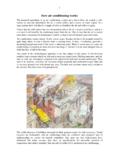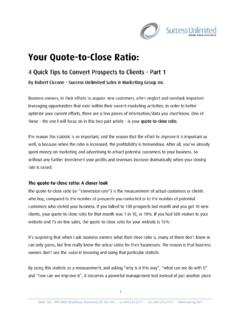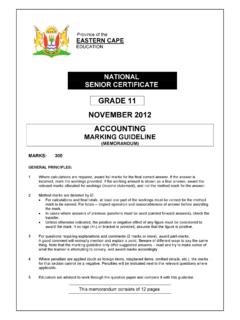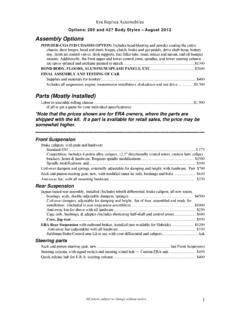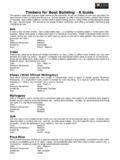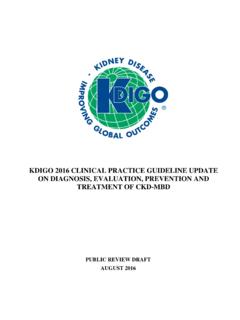Transcription of Equations describing the physical properties of moist air ...
1 Equations describing the physical properties of moist air 1 This is a formal presentation of the formul that describe those properties of water vapour inair that concern conservators. The derivation of these Equations is explained concisely and theuseful Equations are emphasised by bold type. This datasheet is intended for reference, not asa friendly introduction to the topic! Water vapour pressureIn a closed container partly filled with water there will be some water vapour in the spaceabove the water. The concentration of water vapour depends only on the temperature. It is notdependent on the amount of water and is only very slightly influenced by the presence of airin the container.
2 The water vapour exerts a pressure on the walls of the container. The empirical equationsgiven below give a good approximation to the saturation water vapour pressure attemperatures within the limits of the earth's climate. Saturation vapour pressure, ps, in pascals: ps = exp( t / ( t + ) ) where t is the temperature in degrees Celsius Reference: Tetens, O., 1930: Uber einige meteorologische Begriffe. Zeitschrift fur Geophysik,Vol. 6:297. There are more accurate formul given in standard reference works, such as theSmithsonian Tables, but this version is adequate for all but high accuracy laboratory studies.
3 The svp below freezing can be corrected after using the equation above, thus: ps ice = + + The next formula gives a direct result for the saturation vapour pressure over ice: ps ice = exp( / ( 273 + t ) + ) The dew point can be calculated from the actual vapour pressure (vp) by using the inverse ofTetens' equation:dp = ( ln( ))/( - ln( )The pascal is the SI unit of pressure = newtons / m2. Atmospheric pressure is about 100,000Pa (standard atmospheric pressure is defined as 101,300 Pa). Water vapour concentrationThe relationship between vapour pressure and concentration is defined for any gas by theequation: p = nRT/V p is the pressure in Pa, V is the volume in cubic metres, T is the temperature in degrees Kelvin(degrees Celsius + ), n is the quantity of gas expressed in molar mass ( kg in thecase of water ), R is the gas constant: Joules/mol/m3 To convert the water vapour pressure to concentration in kg/m3.)
4 ( Kg / ) / V = p / RTkg/m3 = p / ( t + ) where p is the actual vapour pressure Equations describing the physical properties of moist air 2 Relative HumidityThe Relative Humidity (RH) is the ratio of the actual water vapour pressure to the saturationwater vapour pressure at the prevailing temperature. RH = p/psRH is usually expressed as a percentage rather than as a fraction. In the biological literature,however, the RH is often expressed as a fraction and is then called the water activity. The RH is a ratio. It does not define the water content of the air unless the temperature isgiven.
5 The reason RH is so much used in conservation is that most organic materials have anequilibrium water content that is mainly determined by the RH and is only slightly influencedby temperature. Notice that air is not involved in the definition of RH. Airless space can have a RH. Air is thetransporter of water vapour in the atmosphere and in air conditioning systems, so the phrase"RH of the air" is commonly used, and only occasionally misleading. The independence ofRH from atmospheric pressure is not important on the ground, but it does have somerelevance to calculations concerning air transport of works of art and conservation by freezedrying.
6 The Dew PointThe water vapour content of air is often quoted as dew point. This is the temperature to whichthe air must be cooled before dew condenses from it. At this temperature the actual watervapour content of the air is equal to the saturation water vapour pressure. The dew point isusually calculated from the RH. First one calculates ps, the saturation vapour pressure at theambient temperature. The actual water vapour pressure, pa, is:pa= ps RH% / 100 The next step is to calculate the temperature at which pa would be the saturation vapourpressure. This means running backwards the equation given above for deriving saturationvapour pressure from temperature: Let w = ln ( pa/ ) Dew point = w / ( - w ) This calculation is often used to judge the probability of condensation on windows and withinwalls and roofs of humidified dew point can also be measured directly by cooling a mirror until it fogs.
7 The RH is thengiven by the ratioRH = 100 ps dewpoint/psambientEquations describing the physical properties of moist air 3 Concentration of water vapour in air It is sometimes convenient to quote water vapour concentration as kg/kg of dry air. This isused in air conditioning calculations and is quoted on psychrometric charts. The followingcalculations for water vapour concentration in air apply at ground level. Dry air has a molar mass of kg. It is denser than water vapour, which has a molar massof kg. Therefore, humid air is lighter than dry air. If the total atmospheric pressure is Pand the water vapour pressure is p, the partial pressure of the dry air component is P - p.
8 Theweight ratio of the two components, water vapour and dry air is: kg water vapour / kg dry air = p / ( (P - p ) ) = p / (P - p ) At room temperature P - p is nearly equal to P, which at ground level is close to 100,000 Pa,so, approximately: kg water vapour / kg dry air = 10-5 p Thermal properties of damp air The heat content, usually called the enthalpy, of air rises with increasing water content. Thishidden heat, called latent heat by air conditioning engineers, has to be supplied or removed inorder to change the relative humidity of air, even at a constant temperature. This is relevant toconservators.
9 The transfer of heat from an air stream to a wet surface, which releases watervapour to the air stream at the same time as it cools it, is the basis for psychrometry and manyother microclimatic phenomena. Control of heat transfer can be used to control the drying andwetting of materials during conservation treatment. The enthalpy of dry air is not known. Air at zero degrees celsius is defined to have zeroenthalpy. The enthalpy, in kJ/kg, at any temperature, t, between 0 and 60C is approximately: h = - below zero: h = The enthalpy of liquid water is also defined to be zero at zero degrees celsius. To turn liquidwater to vapour at the same temperature requires a very considerable amount of heat energy:2501 kJ/kg at 0C At temperature t the heat content of water vapour is: hw = 2501 + Notice that water vapour, once generated, also requires more heat than dry air to raise itstemperature further: against about 1 for dry air.
10 The enthalpy of moist air, in kJ/kg, is therefore: h = ( t - ) + g (2501 + t) g is the water content in kg/kg of dry air Equations describing the physical properties of moist air 4 The PsychrometerThe final formula in this collection is the psychrometric equation. The psychrometer is thenearest to an absolute method of measuring RH that the conservator ever needs. It is morereliable than electronic devices, because it depends on the calibration of thermometers ortemperature sensors, which are much more reliable than electrical RH sensors. The psychrometer, or wet and dry bulb thermometer, responds to the RH of the air in thisway: Unsaturated air evaporates water from the wet wick.


